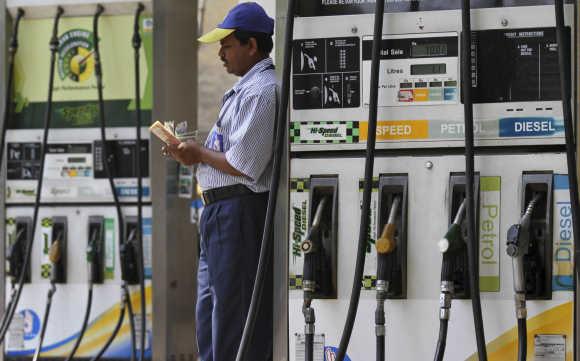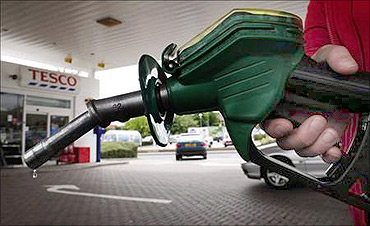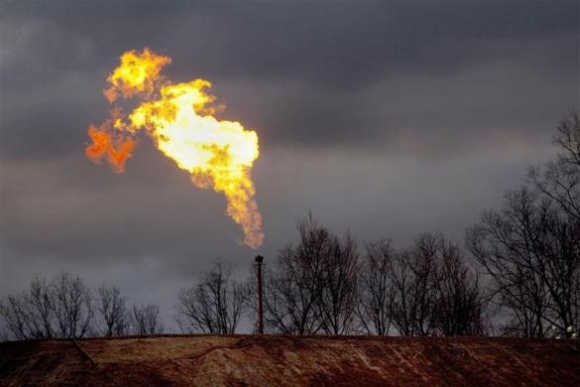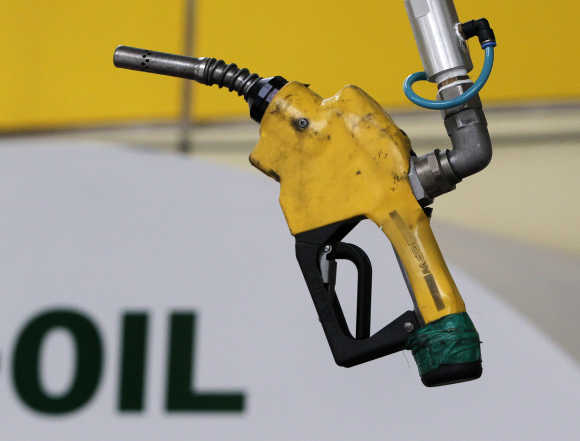 | « Back to article | Print this article |
SHOCKER! Fuel price may rise again in June
June may turn out to be the luckiest month for government oil marketing companies for the third year in a row.
Like the last two years, this June is also expected to see a round of price hikes in controlled fuel products.
Price hikes of controlled petroleum products such as diesel, cooking gas and kerosene have been happening annually in the month of June, irrespective of the companies' losses.
A price increase of petrol is also likely.
This is a departure from the period following the dismantling of the administered pricing mechanism in April 2002.
Click NEXT to read further. . .
SHOCKER! Fuel price may rise again in June
The first year after the APM was dismantled saw as many as 16 price changes, of which 12 were price increases in both petrol and diesel.
While petroleum ministry officials are tight-lipped about the next price increase, industry officials are certain of another hike some time next month as the Budget session of Parliament is scheduled to end on May 22.
Hinting at a fuel price hike, Finance Minister Pranab Mukherjee said in Parliament on Tuesday it was impossible for the government to maintain the current level of fuel subsidies.
He said the government would have to address the under-recoveries of oil marketing companies IndianOil, Bharat Petroleum and Hindustan Petroleum.
Click NEXT to read further. . .
SHOCKER! Fuel price may rise again in June
At the current prices of products, oil companies are likely to see record under-recoveries of Rs 1.8 lakh crore (Rs 1.8 trillion) for the financial year.
The government provided for Rs 40,000 crore (Rs 400 billion) in the Budget towards fuel subsidy and upstream oil companies will chip in with another Rs 68,220 crore (Rs 682.2 billion) at their subsidy share of 37.9 per cent.
The two combined would still leave a gap of Rs 71,780 crore (Rs 717.8 billion).
In June 2010, the government decontrolled petrol and increased prices of diesel, kerosene and cooking gas.
Thereafter, no price increase was effected for a full year in the controlled products -- diesel, kerosene and cooking gas.
Click NEXT to read further. . .
SHOCKER! Fuel price may rise again in June
Exactly a year later, on June 24, 2011, the government allowed an increase in prices of the three regulated products.
This time, it also removed the five per cent customs duty on crude oil, brought down the import duty on petrol and diesel from 7.5 per cent to 2.5 per cent and reduced the excise duty on diesel by Rs 2.6 to Rs 2 per litre, thereby foregoing revenues of Rs 49,000 crore (Rs 490 billion).
However, within a few weeks companies started losing sharply on all these products as global prices continued to increase.
A weakening rupee added to their woes. From barely Rs 5 per litre in July last year, the under-recovery on diesel has touched Rs 14 per litre.
Click NEXT to read further. . .
SHOCKER! Fuel price may rise again in June
"The month of June is a lull period in terms of political activity.
"As there is no Parliament session, reactions will be muted if a price hike is done during June.
"But, this is not a healthy situation for oil companies," said R S Sharma, former ONGC chairman and current chairman of the Ficci Hydrocarbon Committee.
Industry experts, however, see a regular price hike of a small quantum ideal rather than an annual hike that stresses the public.
"Ideally, price hikes should be done in a phased manner so that the consumers are not burdened in one go. I see the June increase as a coincidence but if it happens this time too then it would become a trend," said G C Daga, former director (marketing) at IndianOil.
Click NEXT to read further. . .
SHOCKER! Fuel price may rise again in June
Currently, the three OMCs together lose Rs 570 per day on the regulated sale of diesel, kerosene and domestic cooking gas, according to P K Goyal, director (finance) at IndianOil. Product-wise, the loss is Rs 13.91 per litre of diesel, Rs 31.49 per litre of kerosene and Rs 480 on every domestic cooking gas cylinder.
On petrol, which stands deregulated since June 2010, the revenue loss is Rs 7.17 per litre. The Indian basket of crude oil has averaged $117.64 per barrel so far in the current fiscal, up over five per cent from the previous fiscal's average of $111.89.
With the rupee depreciation, the actual impact is much higher.






